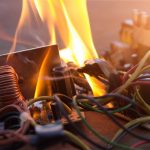A commercial HVAC system plays a critical role in keeping a facility comfortable, productive, and compliant with safety standards. When that system begins to malfunction, it can impact employee performance, damage equipment, and create significant financial strain.
Identifying problems early can help avoid system failure, costly repairs, and unplanned downtime.
Understanding the warning signs is key to keeping your HVAC system running smoothly and efficiently.
Unusual Noises From Equipment
HVAC systems generally operate with a consistent low hum. Any deviation from this normal sound, such as grinding, banging, clanking, or screeching, suggests that internal components are not functioning properly. These sounds may point to loose belts, worn bearings, or failing motors.
Ignoring these noises can lead to major mechanical failures. A rattling sound might indicate that parts have become detached or are striking the housing, while high-pitched whines could signal compressor trouble. Once these issues escalate, the entire system may be compromised, requiring expensive repairs or even replacement.
Inconsistent Temperature Control
One of the most frustrating signs of HVAC trouble is uneven temperature distribution across different zones of the building. Some rooms may feel too hot, while others remain chilly, even when the thermostat is set to a consistent level. This inconsistency usually means that airflow is not properly balanced or that ducts are leaking.
Malfunctioning thermostats, aging insulation, and failing dampers can contribute to this issue. It often goes unnoticed until complaints from building occupants begin to surface. Addressing inconsistent heating or cooling early can prevent broader system imbalances and restore comfort throughout the facility.
Persistent Odors or Smoke Smells
Strange odors from vents are always a red flag. Musty smells can signal mold inside the ducts or near the evaporator coils. A burning odor might suggest electrical issues or overheating parts. If left unaddressed, these conditions can worsen and even pose fire hazards.
Occupants may first notice these smells during system start-up or after long periods of inactivity. Even if the odor fades, the underlying issue may remain. A professional HVAC technician can locate the source and prevent further damage. To avoid safety risks, this warning sign should never be ignored.
Some problems require professional intervention before they escalate. If you’re unsure whether your facility’s HVAC issues warrant expert help, contacting a provider like Lyons Air Conditioning & Heating and similar ones can provide clarity and fast solutions. Their trained technicians can identify root causes, perform thorough diagnostics, and restore system function quickly.
Working with professionals also helps facilities maintain compliance with building codes, safety regulations, and warranty terms. Scheduled evaluations and emergency responses both play a role in extending the lifespan of your HVAC infrastructure and keeping operations on track.
Unexplained Increase in Energy Bills
A spike in energy costs without a corresponding change in usage often points to a drop in HVAC efficiency. Older components, clogged filters, or failing compressors can cause systems to work harder to maintain temperature settings. This extra strain consumes more power, inflating utility bills and reducing the overall lifespan of the equipment.
Regular monitoring of energy consumption is one of the easiest ways to spot HVAC problems early. A comparison between monthly usage data can reveal subtle changes before they become major concerns. When costs keep climbing despite stable conditions, it’s time for a professional assessment.
Excessive Humidity or Poor Air Quality
An HVAC system should regulate both temperature and humidity. If moisture levels begin to rise, it could mean that the system is no longer dehumidifying air effectively. This can result in condensation, mold growth, and uncomfortable indoor environments. Air that feels heavy or damp is more than just unpleasant; it may indicate that key HVAC functions are failing.
Poor indoor air quality can stem from blocked vents, dirty coils, or contaminated ductwork. These issues can lead to allergic reactions, respiratory irritation, and complaints from staff or visitors. Addressing them quickly improves comfort and supports health and safety standards within the facility.
Frequent System Cycling or Extended Runtime
If the HVAC system turns on and off more frequently than usual, or if it runs for long periods without reaching the set temperature, it’s time to take a closer look. Short cycling can wear down parts and reduce the efficiency of the entire system. Prolonged runtimes can point to refrigerant leaks, clogged filters, or failing sensors.
Both issues increase stress on the system and raise operational costs. They may not be obvious unless maintenance personnel track system behavior or conduct routine checks. That’s why it’s important to investigate changes in runtime patterns before small inefficiencies turn into large problems.
Regular maintenance reduces the chances of encountering these warning signs in the first place. Yet even with proper care, systems experience wear due to daily use and environmental exposure. Recognizing and responding to these indicators keeps small issues from spiraling into large disruptions. Whether it’s unusual noise, uneven cooling, or rising utility bills, early attention safeguards your investment and maintains comfort across the facility.







